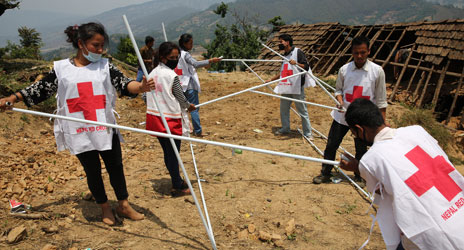You are here
Tents, Tarpaulins and Tigers: Mountain Communities in Nepal Struggle to Cope After the Earthquake
Primary tabs

Red Cross voluntaries hand out tarpaulins and put up tents in the village of Khalckok in Nepal. Palani Mohan/IFRC
ifrc.org - by Patrick Fuller
May 6, 2015
To the casual observer, the busy highway between Kathmandu and the town of Kavere, gives a misleading impression of the extent of the destruction caused by the 25 April earthquake. Life goes on as normal and homes and shops are untouched. It’s not until you turn off the road at the town of Sangha and travel three kilometres up a bumpy dirt track into the surrounding hills, that the true picture of this disaster unfolds.
A team of young Nepal Red Cross Society volunteers is delivering tents and tarpaulins to households in the remote village of Khalchok, perched high on a ridge traversing a series of hill-tops. 115 of the 135 homes in the community are either totally destroyed or uninhabitable. The higher you travel, the worse the damage becomes. When the track ends, the volunteers disembark from the 4-wheeled drive vehicle and start to carry the first of the family tents on a half hour trek up a narrow path to what remains of the home of Subash Lama.
Fortunately the 26-year-old was in the local market when the quake struck, and his wife, parents and other family members were working in the fields. “When I felt the earthquake I had a feeling my home had collapsed,” he said. “I rushed back here and found it had gone. There was just a pile of stones remaining.”
Since then, each night, the family of seven has squeezed into a tiny temporary shelter made from an old piece of plastic sheeting.
Now, Subash has cut timber uprights and bamboo cross-beams to make a cooking area. As well as the tent, provided by the Red Cross Society of China, the volunteers arrive with a tarpaulin which they help Subash to string over the frame of the cooking area so it can also serve as an extra sleeping space.
So far, emergency shelter has been the highest priority for the Red Cross emergency response operation in Nepal and over the past 12 days almost 30,000 tarpaulins – sufficient to shelter 130,000 people – have been distributed to families such as Subash’s, across the 14 worst affected districts surrounding the epicentre of the earthquake.
The tarpaulins are urgently needed. In Kathmandu, they have sheltered the thousands of people too scared to return to their homes, who have resorted to sleeping outdoors.
Although Subash’s family now has a decent place to sleep each night, he still has other concerns.
“My family are scared. There are tigers in the forest and we don’t feel safe. They come here at night and walk right past our shelter. My goat was taken just the other night,” he said.
Aside from the threat posed by tigers, he is faced with a triple burden. He has to tend his fields, find work as a day-labourer to make enough money to feed the family, and he also has to think about how he is going to rebuild his home.
“All my corn stock – our food for the next five months – is now buried under the rubble. I can’t get to it and we have been living off the few relief supplies that people have brought here. My next harvest will be in August. I don’t know how we will manage.”
Sabin Adhikari, a member of the Nepal Red Cross’s national disaster response team, who has been deployed from Kathmandu to Kavare district to support local Red Cross relief efforts in the area, said reconstructing homes is one of the biggest challenges earthquake survivors now face. “People can salvage some building materials but they will need tin roofing sheets, timber and bricks. Most of all they will need a team of masons and carpenters to help them. It will be very costly.”
The International Federation of Red Cross and Red Crescent Societies (IFRC) is already addressing the issue of reconstruction as part of its early and long-term recovery plans.
“People are already starting to rebuild and we are looking at the best options to help them do this quickly and safely,” said Martin Faller, the IFRC’s head of operation. “This will be a major component of our recovery operation over the next 18 months, together with our partners in the Nepal Red Cross Society.”



Comments
Nepalis find community in tent city, but few resources
WASHINGTON POST by Pamela Constable May 9, 2015
KATHMANDU, Nepal — On a vacant field in the middle of this quake-ravaged capital, a community of 600 survivors has formed. Everyone in it is homeless, and many escaped their apartments with little but their lives. Most are strangers, stranded far from village roots in a devastated city where they moved to work or study.
Yet in little over a week, the inhabitants of this emergency tent colony — one of a dozen set up on public parks or vacant land in the capital since the April 25 earthquake that killed more than 7,500 people — have established a collective identity and purpose. A committee of male residents has been formed to register each family for relief aid and manage its distribution.
After the initial chaotic flight from disaster, the informal colony known as Chuchchepati has also developed a daily rhythm. The routine is anchored by the midday arrival of relief trucks from an India-based charity with vats of rice and lentils, a festive and crowded occasion that relieves the ennui of waiting and lifts spirits....
Among the hundreds of thousands of Nepalis left homeless by the quake, these displaced urban residents have certain advantages over rural families in the same situation. Although they lack traditional community bonds or safety nets, they are better educated, easier for relief groups to reach, and close to city services and shops...
Read complete story.
http://www.washingtonpost.com/world/asia_pacific/nepalis-find-community-in-tent-city-but-few-resources/2015/05/07/ec57016c-f329-11e4-bca5-21b51bbdf93e_story.html